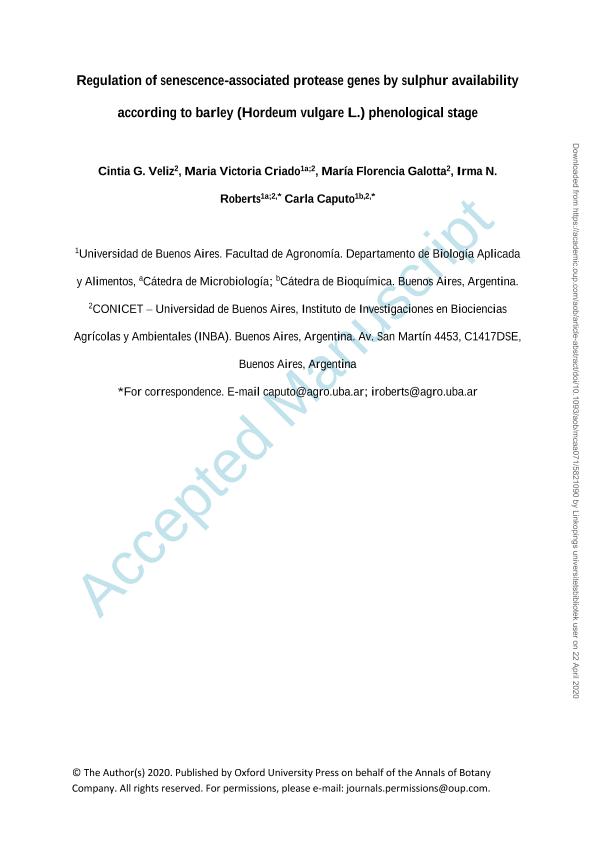Mostrar el registro sencillo del ítem
dc.contributor.author
Veliz, Cintia Gabriela

dc.contributor.author
Criado, Maria Victoria

dc.contributor.author
Galotta, María Florencia

dc.contributor.author
Roberts, Irma

dc.contributor.author
Caputo Suarez, Carla Paula

dc.date.available
2022-09-27T10:37:27Z
dc.date.issued
2020-04
dc.identifier.citation
Veliz, Cintia Gabriela; Criado, Maria Victoria; Galotta, María Florencia; Roberts, Irma; Caputo Suarez, Carla Paula; Regulation of senescence-associated protease genes by sulphur availability according to barley (Hordeum vulgare L.) phenological stage; Oxford University Press; Annals of Botany; 126; 3; 4-2020; 435-444
dc.identifier.issn
0305-7364
dc.identifier.uri
http://hdl.handle.net/11336/170541
dc.description.abstract
Background and Aims: Proteases are responsible for protein degradation during leaf senescence, allowing nutrients to be redirected to sink tissues. In a previous work, we reported that sulphur deficiency produced a delay in the leaf senescence of barley (Hordeum vulgare L.) plants, at both vegetative and reproductive stages. In this work, we analyse the effect of sulphur deficiency on the expression of several genes coding for proteases of different catalytic groups, which have been strongly associated with leaf senescence. Methods: Four independent experiments were performed in order to impose low sulphur availability conditions: one of steady-state sulphur deficiency during the vegetative stage and three of sulphur starvation during vegetative and reproductive stages. Key Results: Sulphur deficiency inhibited or reduced the senescence-associated induction of seven of the eight proteases analysed. Their induction, as well as senescence and phloem amino acid remobilization, could be achieved with senescence inducers such as methyl-jasmonate (a hormonal stimulus) and darkness, but with different rates of induction dependent on each gene. Sulphur deficiency also exerted an opposite effect on the expression of two cysteine-protease genes (HvSAG12 and HvLEGU) as well as on one serine-protease gene (HvSUBT) according to leaf age and plant phenological stages. All three genes were induced in green leaves but were repressed in senescent leaves of sulphur-deficient plants at the vegetative stage. At the reproductive stage, both cysteine-proteases were only repressed in senescent leaves, while the serine-protease was induced in green and senescent leaves by sulphur deficiency. Conclusions: Our results highlight the relevance of adequate sulphur nutrition in order to ensure leaf senescence onset and induction of protease genes, which will consequently impact on grain protein composition and quality. In addition, our results provide evidence that leaf age, plant developmental stage and the nature of the stress modulate the sulphur responses.
dc.format
application/pdf
dc.language.iso
eng
dc.publisher
Oxford University Press

dc.rights
info:eu-repo/semantics/openAccess
dc.rights.uri
https://creativecommons.org/licenses/by-nc-sa/2.5/ar/
dc.subject
BARLEY (HORDEUM VULGARE L
dc.subject
GENE EXPRESSION
dc.subject
PROTEASES
dc.subject
SENESCENCE
dc.subject
SULPHUR DEFICIENCY
dc.subject.classification
Otras Ciencias Agrícolas

dc.subject.classification
Otras Ciencias Agrícolas

dc.subject.classification
CIENCIAS AGRÍCOLAS

dc.title
Regulation of senescence-associated protease genes by sulphur availability according to barley (Hordeum vulgare L.) phenological stage
dc.type
info:eu-repo/semantics/article
dc.type
info:ar-repo/semantics/artículo
dc.type
info:eu-repo/semantics/publishedVersion
dc.date.updated
2021-04-28T21:34:34Z
dc.journal.volume
126
dc.journal.number
3
dc.journal.pagination
435-444
dc.journal.pais
Reino Unido

dc.journal.ciudad
Oxford
dc.description.fil
Fil: Veliz, Cintia Gabriela. Consejo Nacional de Investigaciones Científicas y Técnicas. Oficina de Coordinación Administrativa Parque Centenario. Instituto de Investigaciones en Biociencias Agrícolas y Ambientales. Universidad de Buenos Aires. Facultad de Agronomía. Instituto de Investigaciones en Biociencias Agrícolas y Ambientales; Argentina
dc.description.fil
Fil: Criado, Maria Victoria. Consejo Nacional de Investigaciones Científicas y Técnicas. Oficina de Coordinación Administrativa Parque Centenario. Instituto de Investigaciones en Biociencias Agrícolas y Ambientales. Universidad de Buenos Aires. Facultad de Agronomía. Instituto de Investigaciones en Biociencias Agrícolas y Ambientales; Argentina
dc.description.fil
Fil: Galotta, María Florencia. Consejo Nacional de Investigaciones Científicas y Técnicas. Oficina de Coordinación Administrativa Parque Centenario. Instituto de Investigaciones en Biociencias Agrícolas y Ambientales. Universidad de Buenos Aires. Facultad de Agronomía. Instituto de Investigaciones en Biociencias Agrícolas y Ambientales; Argentina
dc.description.fil
Fil: Roberts, Irma. Consejo Nacional de Investigaciones Científicas y Técnicas. Oficina de Coordinación Administrativa Parque Centenario. Instituto de Investigaciones en Biociencias Agrícolas y Ambientales. Universidad de Buenos Aires. Facultad de Agronomía. Instituto de Investigaciones en Biociencias Agrícolas y Ambientales; Argentina
dc.description.fil
Fil: Caputo Suarez, Carla Paula. Consejo Nacional de Investigaciones Científicas y Técnicas. Oficina de Coordinación Administrativa Parque Centenario. Instituto de Investigaciones en Biociencias Agrícolas y Ambientales. Universidad de Buenos Aires. Facultad de Agronomía. Instituto de Investigaciones en Biociencias Agrícolas y Ambientales; Argentina
dc.journal.title
Annals of Botany

dc.relation.alternativeid
info:eu-repo/semantics/altIdentifier/url/https://academic.oup.com/aob/article/126/3/435/5821090
dc.relation.alternativeid
info:eu-repo/semantics/altIdentifier/doi/http://dx.doi.org/10.1093/aob/mcaa071
Archivos asociados
